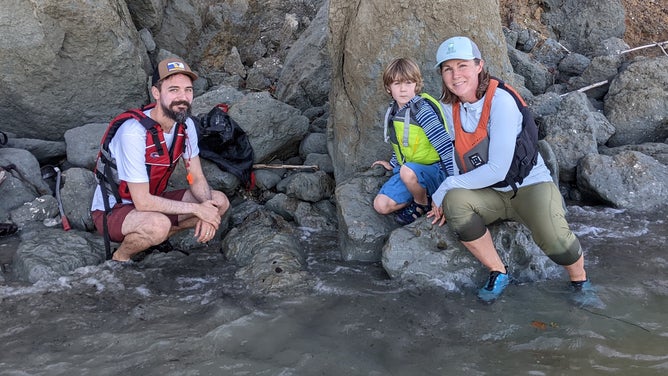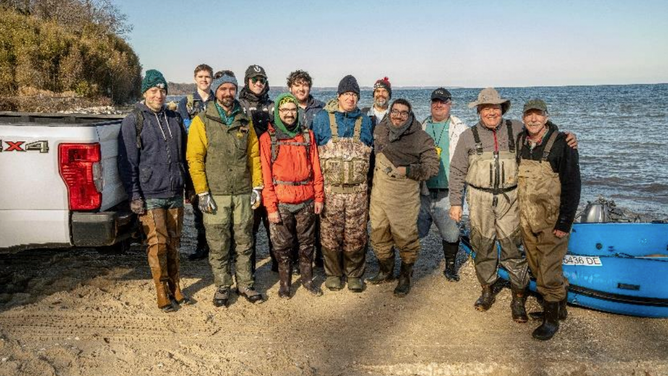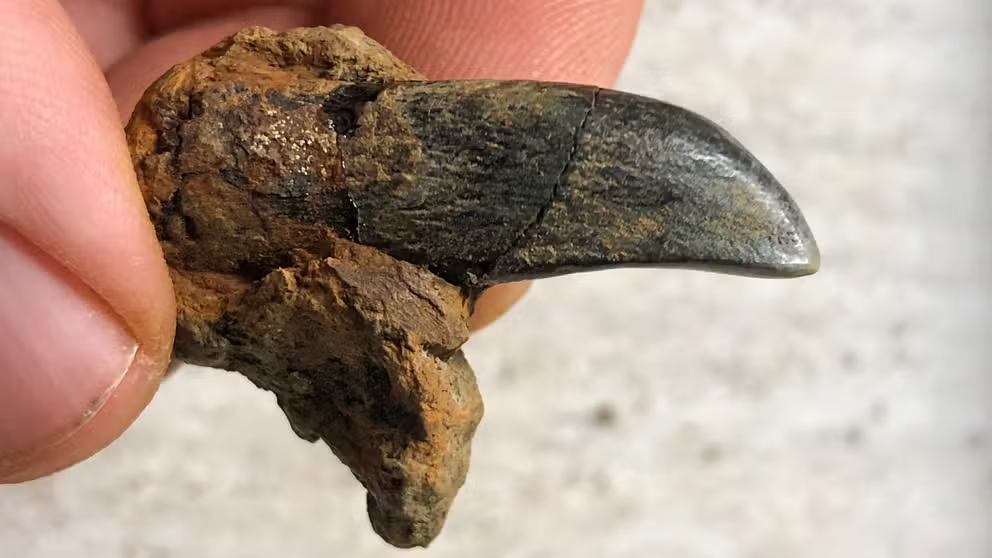'Unusual' 650-pound fossil whale skull found in Maryland estimated to be 12 million years old
The discovery was made in October, but due to the fossil’s sheer size, it was only extracted two months later in December. It was then brought to paleontologists at the Calvert Marine Museum in nearby Solomons, Maryland.
How kids at Dinosaur Park are finding bones with help from the rain
Located in Laurel, Maryland, Dinosaur Park is an outdoor laboratory where paleontologists, park visitors, and the weather combine forces to discover hundreds of fossils.
ST. LEONARD, Md. – A Pennsylvania family discovered a 650-lb fossil whale skull on the Chesapeake Bay in southern Maryland.
Cody Goddard, his wife and their son were on Matoaka Beach in Calvert County when they saw a large, hardened block of sediment laying on the beach. According to the Calvert Marine Museum, the sediment had an "unusual" fossil protruding from one end.

Cody Goddard with wife Laura MacLean and son Brennan on the day of discovery. The whale skull is in the partially submerged block of sediment just in front of, and below Cody’s left knee.
(S. Godfrey / Calvert Marine Museum / FOX Weather)
The discovery was made in October, but due to the fossil's sheer size it took about two months for the fossil to be extracted.
The whale skull fossil was about five and a half feet long, 18 inches wide and weighed approximately 650 pounds, according to the curator of paleontology at the Calvert Marine Museum, Stephen J. Godfrey.
Godfrey was contacted by Goddard about his discovery in October and worked with him to examine the large fossil.

Team lifting skull into truck.
(Calvert Marine Museum / FOX Weather)
Godfrey stated that the weight of the fossil mostly came, not from the skull itself, but from the unusual, cemented sediment that had formed around the skull.
"In a way, it created its own sarcophagus – its own little burial chamber that preserved it for millions of years and for us to be able to find," he said.
MUMMY BY NATURE: HOW THE DESERT HEAT PRESERVED DEAD BODIES IN PREHISTORIC EGYPT
On December 19, Godfrey and his team from the Calvert Marine Museum Fossil Club successfully removed the fossil from the beach and brought it to the bayside museum for further research.

The team that collected the fossil. From left to right: Chris Storck, Marcus Jones, Cody Goddard, David Hoppe, Dr. Geoff Bowers, Stephen Groff, John Nance, Bill Prochownik, Dr. Victor Perez, Paul Murdoch, Walt Johns, and Dr. Stephen Godfrey. (Not pictured are Terrell Gross, John Bennett, and Rebecca Benton from Calvert County’s Communications & Media Relations, along with Kevin Schmidt).
(Kevin Schmidt / FOX Weather)
According to Godfrey, the skull is around 12 million years old, based on the sediment age along Calvert Cliffs. The skull came from a baleen whale, a type of whale that uses its teeth to filter its prey, plankton, from ocean water.
Compared to modern baleen whales, such as humpback whales, the prehistoric whale the skull came from was quite small and narrow at 5.5 feet long and about 18 inches wide.
"This would have been a very hydrodynamic type of whale, so it could probably swim fairly quickly," Godfrey said. "And, of course, you'd want to because you have Megalodon swimming at that time, and you're doing all you can to avoid being Megalodon’s next meal."
MEGALODON SHARK TOOTH DISCOVERED BY 9-YEAR-OLD GIRL IN MARYLAND
Godfrey noted that the skull would be more completely analyzed in about two months, which will be the amount of time needed to remove the hardened sediment surrounding the skull.
When the skull is free of sediment, Godfrey and his team will be able to determine which baleen whale species the skull belonged to.
According to the Calvert Marine Museum, the skull – called "Cody" after Cody Goddard – is the most complete fossil whale skull ever recovered from that section of Calvert Cliffs.


